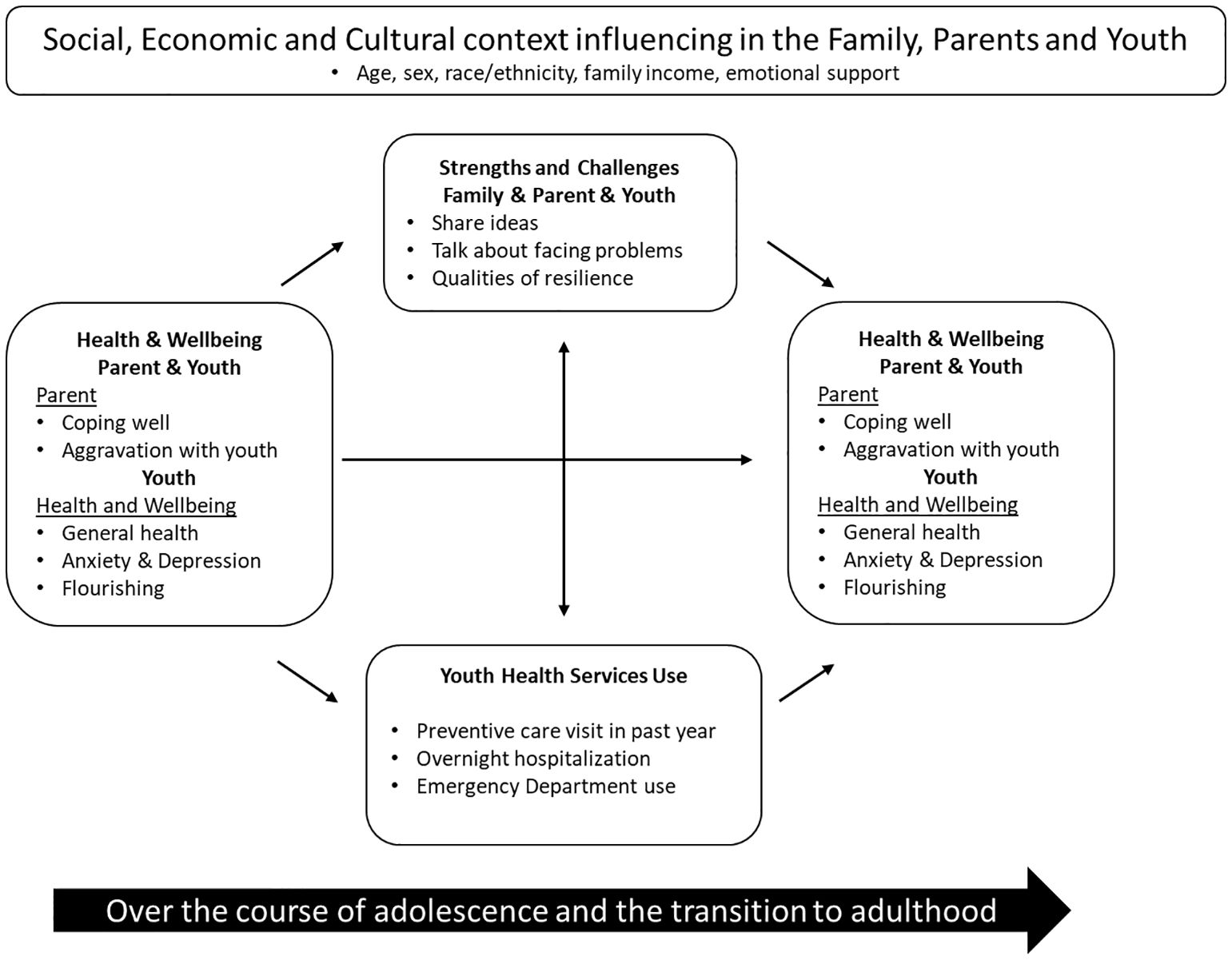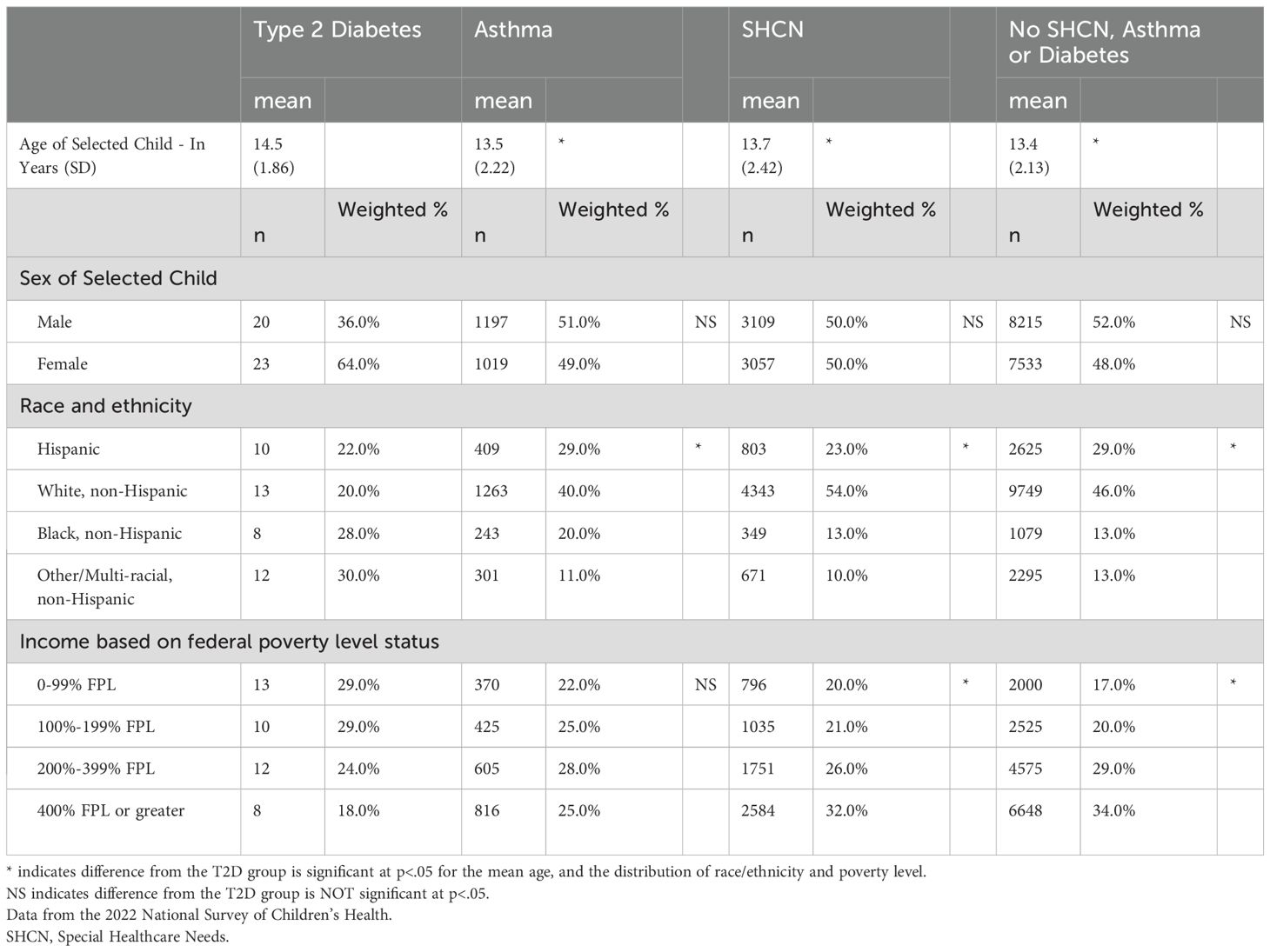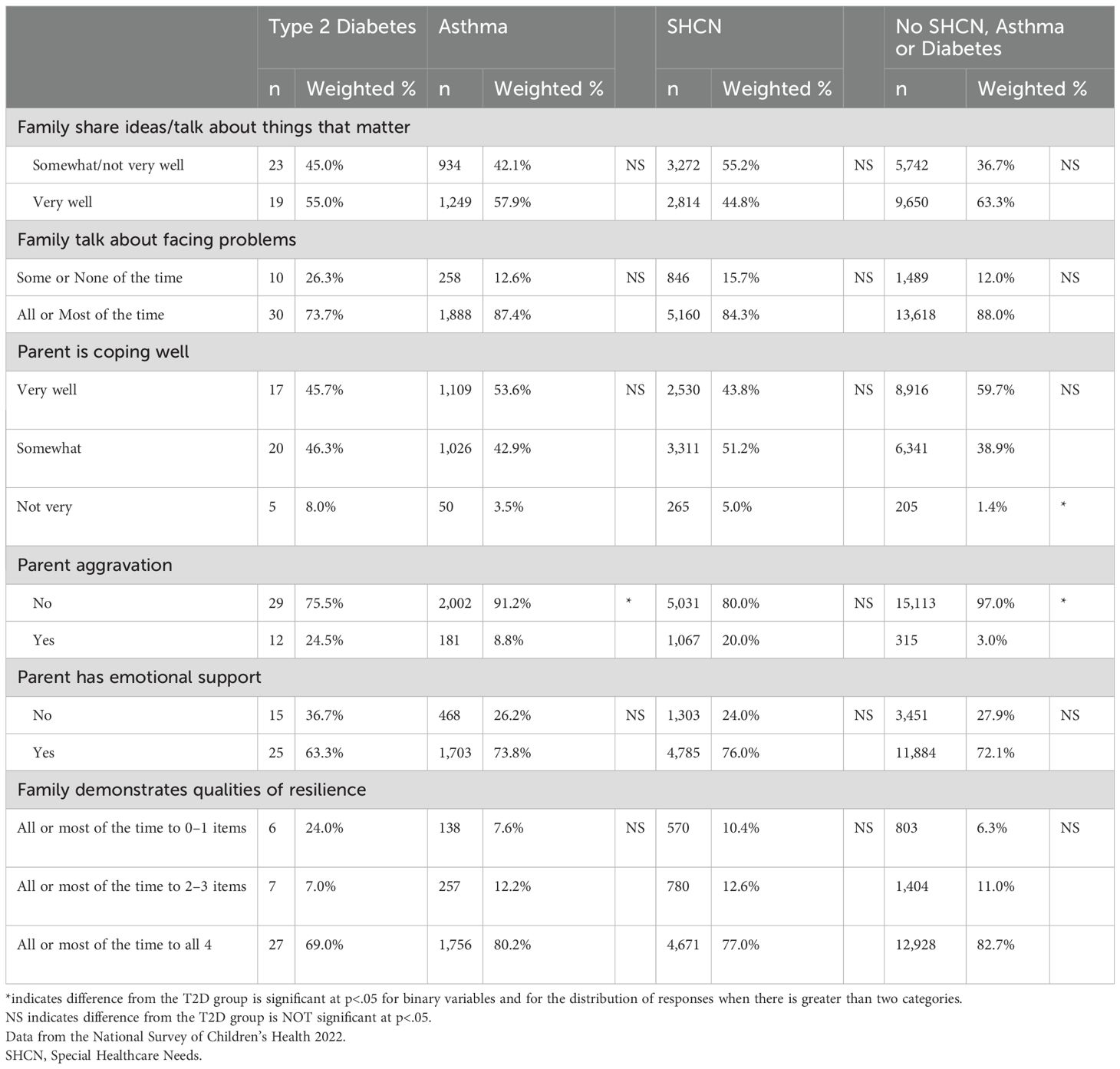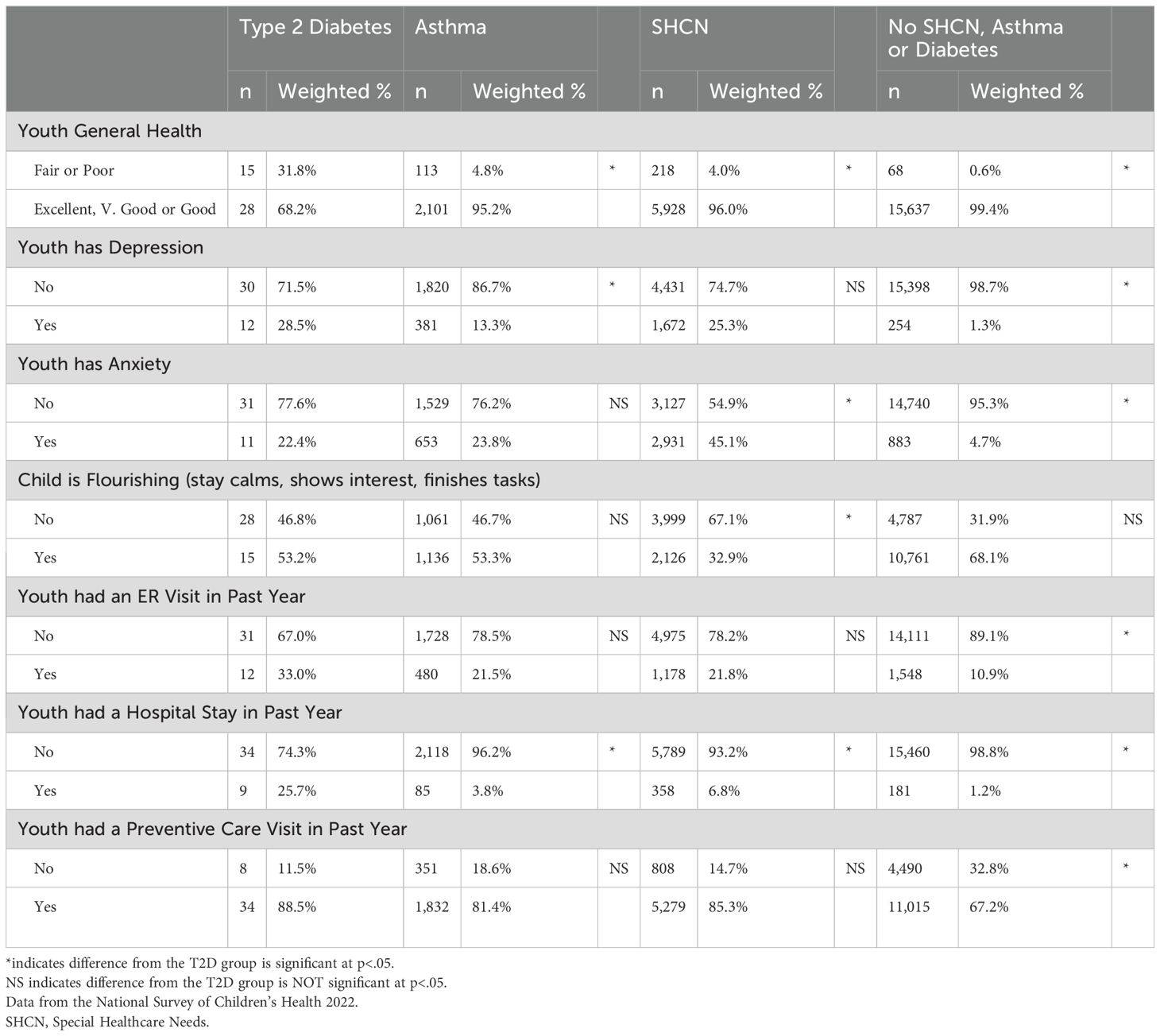- 1Division of Clinical Behavioral Neuroscience, Department of Pediatrics, University of Minnesota, Minneapolis, MN, United States
- 2Division of Pediatric Endocrinology, Department of Pediatrics, Center for Pediatric Obesity Medicine, University of Minnesota, Minneapolis, MN, United States
- 3Psychology Department, Clark University, Worcester, MA, United States
- 4Division of General Pediatrics and Adolescent Health, Department of Pediatrics, University of Minnesota, Minneapolis, MN, United States
Introduction: Type 2 diabetes is a complex chronic illness requiring significant support. The goal of this study is to better understand stressors associated with type 2 diabetes for adolescents and caregivers and their impact on family functioning and health status.
Methods: Using the National Survey of Children’s Health, this study examined differences in adolescent mental health, family and caregiver functioning, and medical service usage in pediatric type 2 diabetes, asthma, special healthcare needs, and adolescents without chronic illness.
Results: Adolescents and families with type 2 diabetes demonstrated higher mental health concerns, poorer parental coping and family resilience, and higher use of emergency care than one or more of the comparison groups. Emergency care needs were also higher than expected for type 2 diabetes.
Discussion: Adolescents with type 2 diabetes and their caregivers reported significant stressors and functioning concerns as compared to adolescents with and without another chronic illness. These families also required more intensive care needs, highlighting the need to support adolescent and family psychosocial functioning in the context of type 2 diabetes.
Introduction
There has been a significant increase in pediatric type 2 diabetes, coinciding with the rise in pediatric obesity (1). The rate of type 2 diabetes is rising most amongst minority youth, particularly Latine and Non-Hispanic Black populations, which have been shown to present with higher hemoglobin A1c, comorbidities, and complications (1, 2). Youth with type 2 diabetes report lower healthcare-related quality of life (QOL) as compared to youth with type 1 diabetes or other chronic conditions.
In addition to low QOL and medical adherences, youth with type 2 diabetes demonstrate significant mental health concerns, including higher rates of depressive symptoms, difficulties with adherence and psychosocial functioning, and lower self-reported healthcare-related quality of life (HQoL) (3). In addition to the cognitive, behavioral, and social challenges related to understanding and managing a new chronic medical condition (St. 4), many youth with type 2 diabetes experience comorbid obesity, which is associated with weight-related external and internal stigma and bias (5). Stigma associated with obesity may also exacerbate challenges associated with type 2 diabetes, as those using insulin reported higher rates of diabetes stigma (6, 7).
Given these complexities, the American Diabetes Association (ADA) (8) recommends that all youth with type 2 diabetes receive comprehensive diabetes education and support, in addition to weight management programs that are developmentally and culturally appropriate as needed. Family lifestyle and behavior modifications are also an important component of intervention (9). For adults with type 2 diabetes, social support has been found to improve glycemic control and limit emotional distress (10). Family functioning and behavioral problems have also been found to impact adherence and glycemic control in type 1 diabetes (11). Despite the strong need for family-based lifestyle modifications in type 2 diabetes and the impact family functioning can have on pediatric obesity (12), little is known about the relation between family functioning and disease management in pediatric type 2 diabetes.
Understanding family, parent, and youth stressors and functioning, parent-child relationships, and the impact of these on youth physical and mental health may help to develop more comprehensive and effective interventions for youth with type 2 diabetes and their families.
Thus, using the National Survey of Children’s Health (NSCH) (13), this cross-sectional study examined the relationship between stressors, including parent and family functioning, physical, and mental health outcomes, in type 2 diabetes as compared to youth with other chronic illnesses, special healthcare needs (SHCN), and those without chronic illness.
Method
Overview: This study is a secondary exploratory analysis of data from the 2022 NSCH, a household survey fielded annually for the purpose of examining the health and wellbeing, as well as their determinants, of children ages birth - 17 years in the United States. Beginning in 2022, the NSCH includes questions which identify children and adolescents with type 2 diabetes within the overall sample– providing a unique opportunity to pursue this research.
Sampling and Data Collection: The NSCH employs stratified sampling to create a sample capable of generating national and state level estimates. The questionnaire is completed in English or Spanish by a parent or knowledgeable adult and covers topics related to the randomly chosen child and the adult respondent, the household and neighborhood. Of the initial 358,000 households queried, 122,000 completed the screening; 67,269 households had children; and 54,103 completed the detailed questionnaire. The overall response rate is 39.1%.
Respondents were parents or caregivers of adolescents, categorized into one of four groups based on the adolescent’s health condition: 1) type 2 diabetes, 2) asthma, 3) special healthcare needs, or 4) no chronic condition. Categories were selected based on the availability of identifying questions and sample sizes.
Items selected for this analysis represent the stress, coping, and resilience paradigms that frame this analysis (Figure 1).

Figure 1. Conceptual Model Linking Family, Parent and Youth Health. The model depicts the bidirectional relations among strengths and challenges that the family and youth face, youth and parent coping and well-being, and healthcare service use during the transition from adolescence to adulthood.
Data and Resource Availability: The dataset analyzed in the current study is available at the Data Resource Center for Child and Adolescent Health. The dataset includes both individual questions and aggregated constructs (i.e., parent aggravation) compiled by the distributors to assure consistency of use among analysts. P.B.S. acquired the dataset and takes responsibility for the accuracy of the data analysis.
Analysis: For descriptive analysis, unweighted frequencies are reported. All other values and statistical tests are calculated using the NCHS provided sample weights and survey design variables to allow for generalization to the US population and adjusting for standard errors. Differences between the type 2 diabetes cohort and each other cohort were tested individually using a parametric Wald test, which evaluates model-based estimates under the specified distributional assumptions of the regression model. Differences between binary dependent variables were examined individually using logit regression with multinomial logit applied to categorical variables and linear regression for mean differences. Regression analysis does not control for sociodemographic differences, as the focus is on the lived experience and population differences, rather than condition-specific effects, potentially offering better insights for clinicians and program planning (14). Differences are reported when the p-value is less than 0.05. Due to the limited sample size of youth with type 2 diabetes (n=45) and the exploratory nature of the study, we did not adjust for multiple comparisons. Adjustment techniques, such as the Bonferroni correction, are exceedingly cautious and can significantly elevate the likelihood of Type II error, especially in small samples, hence potentially masking significant contrasts (15).
IRB: This study was determined to be exempt from regulation as not human research by the University of Minnesota Human Subjects Research Protection Program.
Results
Our analysis identified 43 adolescents (ages 10–17 years) with type 2 diabetes with the prevalence somewhat lower (Wald test, p=0.144) among those aged 10–14 years (0.17%, 95% CI: 0.05%-0.28%) compared to adolescents aged 15–17 years (0.32%, 95% CI: 0.15%-0.48%). Demographic characteristics are detailed in Table 1.
Parents of adolescents with type 2 diabetes differed from one or more groups in the following: poor coping, feelings of aggravation towards their adolescent, and extent of family resilience. (Table 2).
Adolescents with type 2 diabetes were reported to have poorer health, higher rates of depression and anxiety, lower flourishing scores and higher hospitalization (25.7%) and emergency department (ED) use (33.0%) than those in one or more of the other groups. (Table 3). Analyses testing for differences between groups controlling for socio-demographic characteristics is available from the authors.
Discussion
Parents reported high psychosocial stress, aggravation, and low resilience when compared to parents of children without chronic illness, which can significantly impact functioning (16). Consistent with the literature, caregivers of adolescents with type 2 diabetes reported significantly greater mental health concerns, specifically higher rates of depression, as compared to caregivers of youth without a chronic condition, as well as caregivers of youth with asthma. Despite more regular healthcare appointments, they also indicated greater use of emergency and hospital services, which is particularly concerning for adherence and transition to more independent adult care.
These findings underline the importance of psychosocial support not only for pediatric patients with type 2 diabetes, but for their families. Psychosocial interventions have been found to be helpful for children and families across a variety of pediatric chronic illnesses (17, 18). The literature on pediatric weight management emphasizes the importance of a family-based approach for lifestyle change that provides support to parents in addition to the identified patient (19). While there is often overlap in weight management and type 2 diabetes care, there are also unique challenges associated with type 2 diabetes (e.g., insulin management, diabetes stigma) that require specific intervention strategies. Despite the need for specific intervention, few studies have examined psychosocial intervention for families and adolescents with type 2 diabetes (20, 21), with previous studies primarily examining behavioral lifestyle modification without specific parenting support. Thus, parenting support in type 2 diabetes continues to be an area of need (22).
This study highlights the unique challenges associated with type 2 diabetes for patients and families regarding parenting challenges, resilience, and child flourishing. The study presents several limitations, including reliance on self-reported survey data, which opens the possibility of bias and misreporting of healthcare data. The response rate is also low, which can leave the possibility of response bias. The sample size for type 2 diabetes is also small and questions were limited to those available on the standardized survey, which does not allow for more refined understanding of variable studied. Another limitation is the use of multiple comparisons, which may increase the likelihood of Type I error. Despite these limitations, this study also provides a unique opportunity to examine the impact of type 2 diabetes for pediatric patients and their families using a nationally representative group. Further investigation of stressors for children with type 2 diabetes and their families using a larger sample size is required in future studies. Future directions should also examine targeted psychosocial intervention for children and their families with type 2 diabetes, including child and family behavioral health interventions, mental health supports for parents due to stressors associated with parenting a child with a chronic health condition, and targeted social work supports (e.g., financial support for healthier foods, access to transportation to appointments). These could also include eHealth interventions, which have demonstrated efficacy, while reducing the burden of multiple appointments on families (23). Thus, future intervention studies for parenting, psychosocial, and lifestyle stressors associated with type 2 diabetes are necessary.
Data availability statement
The original contributions presented in the study are included in the article/supplementary material. Further inquiries can be directed to the corresponding author. The dataset, including constructed variables, are also publicly available to download at https://www.childhealthdata.org/.
Ethics statement
The studies involving humans were approved by University of Minnesota Institutional Review Board. The studies were conducted in accordance with the local legislation and institutional requirements. Written informed consent for participation was not required from the participants or the participants’ legal guardians/next of kin in accordance with the national legislation and institutional requirements.
Author contributions
NS: Conceptualization, Methodology, Resources, Writing – original draft, Writing – review & editing. MB: Conceptualization, Methodology, Resources, Writing – original draft, Writing – review & editing. WG: Conceptualization, Methodology, Writing – original draft, Writing – review & editing. PS: Conceptualization, Data curation, Formal Analysis, Methodology, Resources, Visualization, Writing – original draft, Writing – review & editing.
Funding
The author(s) declare that no financial support was received for the research and/or publication of this article.
Acknowledgments
The authors have no additional acknowledgements.
Conflict of interest
MB is supported by NIH NIDDK Grant #K23DK129721 and MB is also supported by Abbott.
The remaining authors declare that the research was conducted in the absence of any commercial or financial relationships that could be construed as a potential conflict of interest.
Generative AI statement
The author(s) declare that no Generative AI was used in the creation of this manuscript.
Publisher’s note
All claims expressed in this article are solely those of the authors and do not necessarily represent those of their affiliated organizations, or those of the publisher, the editors and the reviewers. Any product that may be evaluated in this article, or claim that may be made by its manufacturer, is not guaranteed or endorsed by the publisher.
References
1. Hamman RF, Bell RA, Dabelea D, D’Agostino RB, et al. The SEARCH for diabetes in youth study: rationale, findings, and future directions. Diabetes Care. (2014) 37:3336–44. doi: 10.2337/DC14-0574
2. Bacha F, Cheng P, Gal RL, Beaulieu LC, Kollman C, Adolph A, et al. Racial and ethnic disparities in comorbidities in youth with type 2 diabetes in the pediatric diabetes consortium (PDC). Diabetes Care. (2021) 44:2245–515. doi: 10.2337/dc21-0143
3. Walders-Abramson N, Venditti EM, Ievers-Landis CE, Anderson B, Geffner M, Kaplan J, et al. Relationships among Stressful Life Events and Physiological Markers, Treatment Adherence, and Psychosocial Functioning among Youth with Type 2 Diabetes. J Pediatr. (2014) 165:504–85. doi: 10.1016/j.jpeds.2014.05.020
4. George SM St., Pulgarón ER, Ferranti D, Agosto Y, Toro MI, Ramseur KC, et al. A qualitative study of cognitive, behavioral, and psychosocial challenges associated with pediatric type 2 diabetes in ethnic minority parents and adolescents. The Diabetes Educator (2017) 43:180–895. doi: 10.1177/0145721717691146
5. Butt M, Harvey A, Khesroh E, Rigby A, and Paul IM. Assessment and impact of paediatric internalized weight bias: A systematic review. Pediatr Obes. (2023) 18:e130405. doi: 10.1111/ijpo.13040
6. Puhl RM and Lessard LM. Weight stigma in youth: prevalence, consequences, and considerations for clinical practice. Curr Obes Rep. (2020) 9:402–115. doi: 10.1007/S13679-020-00408-8/METRICS
7. Eitel KB, Roberts AJ, D’Agostino R Jr., Barrett CE, Bell RA, Bellatorre A, et al. Diabetes stigma and clinical outcomes in adolescents and young adults: the SEARCH for diabetes in youth study. Diabetes Care. (2023) 46:811–185. doi: 10.2337/dc22-1749
8. American Diabetes Association Professional Practice Committee. 14. Children and adolescents: standards of medical care in diabetes—2022. Diabetes Care. (2022) 45:S208–31. doi: 10.2337/dc22-S014
9. Temneanu OR, Trandafir LM, and Purcarea MR. Type 2 diabetes mellitus in children and adolescents: A relatively new clinical problem within pediatric practice. J Med Life. (2016) 9:235.
10. Perrin N, Bodicoat DH, Davies MJ, Robertson N, Snoek FJ, and Khunti K. Effectiveness of psychoeducational interventions for the treatment of diabetes-specific emotional distress and glycaemic control in people with type 2 diabetes: A systematic review and meta-analysis. Primary Care Diabetes. (2019) 13:556–675. doi: 10.1016/j.pcd.2019.04.001
11. Cohen DM, Lumley MA, Naar-King S, Partridge Ty, and Cakan N. Child behavior problems and family functioning as predictors of adherence and glycemic control in economically disadvantaged children with type 1 diabetes: A prospective study. J Pediatr Psychol. (2004) 29:171–845. doi: 10.1093/JPEPSY/JSH019
12. Halliday JA, Palma CL, Mellor D, Green J, and Renzaho AMN. The relationship between family functioning and child and adolescent overweight and obesity: A systematic review. Int J Obes 2014. (2013) 38:480–93. doi: 10.1038/ijo.2013.213
13. Child and Adolescent Health Measurement Initiative. National survey of children’s health indicator data set. Data Resource Center Child Adolesc Health. (2022).
14. Bauer GR, Churchill SM, Mahendran M, Walwyn C, Lizotte D, and Villa-Rueda AA. Intersectionality in quantitative research: A systematic review of its emergence and applications of theory and methods. SSM- Population Health. (2021) 14:100798. doi: 10.1016/j.ssmph.2021.100798
15. Bender R and Lange S. Adjusting for multiple testing–when and how? J Clin Epidemiol. (2001) 54:343–9. doi: 10.1016/S0895-4356(00)00314-0
16. Qiu Y, Xu L, Pan Y, He C, Huang Y, Xu H, et al. Family resilience, parenting styles and psychosocial adjustment of children with chronic illness: A cross-sectional study. Front Psychiatry. (2021) 12:646421. doi: 10.3389/fpsyt.2021.646421
17. Kahana S, Drotar D, and Frazier T. Meta-analysis of psychological interventions to promote adherence to treatment in pediatric chronic health conditions. J Pediatr Psychol. (2008) 33:590–6115. doi: 10.1093/jpepsy/jsm128
18. Mullins LL, Molzon ES, Suorsa KI, Tackett AP, Pai ALH, and Chaney JM. Models of resilience: developing psychosocial interventions for parents of children with chronic health conditions. Family Relations. (2015) 64:176–895. doi: 10.1111/fare.2015.64.issue-1
19. Tully L, Arthurs N, Wyse C, Browne S, Case L, McCrea L, et al. Guidelines for treating child and adolescent obesity: A systematic review. Front Nutr. (2022) 9:902865. doi: 10.3389/fnut.2022.902865
20. TODAY Study Group. A clinical trial to maintain glycemic control in youth with type 2 diabetes. New Engl J Med. (2012) 366:2247–56. doi: 10.1056/NEJMoa1109333
21. Chambers RA, Rosenstock S, Neault N, Kenney A, Richards J, Begay K, et al. A home-visiting diabetes prevention and management program for American Indian youth: the together on diabetes trial. Diabetes Educator. (2015) 41:729–47. doi: 10.1177/0145721715608953
22. Hilliard ME, Powell PW, and Anderson BJ. Evidence-based behavioral interventions to promote diabetes management in children, adolescents, and families. Am Psychol. (2016) 71:590–6015. doi: 10.1037/A0040359
Keywords: family functioning, adolescent health, type 2 diabetes, healthcare use, stress
Citation: Slesinger Roy NC, Bensignor MO, Grolnick WS and Scal PB (2025) The impact of type 2 diabetes on adolescent and family functioning and healthcare use: findings from the National Survey of Children’s Health. Front. Endocrinol. 16:1589745. doi: 10.3389/fendo.2025.1589745
Received: 07 March 2025; Accepted: 12 May 2025;
Published: 16 June 2025.
Edited by:
Ronald Cohen, The University of Chicago, United StatesReviewed by:
Mariangela Martino, Bambino Gesù Childrens’ Hospital, ItalyKhadija Hafidh, Dubai Health Authority, United Arab Emirates
Yaqin Si, North Carolina State University, United States
Copyright © 2025 Slesinger Roy, Bensignor, Grolnick and Scal. This is an open-access article distributed under the terms of the Creative Commons Attribution License (CC BY). The use, distribution or reproduction in other forums is permitted, provided the original author(s) and the copyright owner(s) are credited and that the original publication in this journal is cited, in accordance with accepted academic practice. No use, distribution or reproduction is permitted which does not comply with these terms.
*Correspondence: Noël C. Slesinger Roy, c2xlc2kwMDJAdW1uLmVkdQ==
 Noël C. Slesinger Roy
Noël C. Slesinger Roy Megan O. Bensignor
Megan O. Bensignor Wendy S. Grolnick3
Wendy S. Grolnick3

